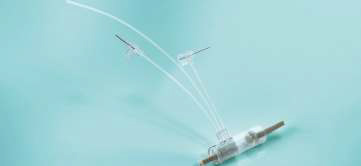|
Co-Extruded Tubing : An
Important Component Of The Fluid Outlet In Drug Delivery
Complex requirements, user-friendly solutions
Process engineering knowhow and materials expertise
are crucial to any project from the beginning. For the past two years, Daniel
Mielert has led a team of eight in customer drugdelivery projects, an important
market for the medical and pharmaceutical industry, in part because more than
537 million people worldwide now suffer from diabetes.
A versatile prodigy for modern drug-delivery systems
 Coextruded tubing has a minimum internal diameter of
up to only 0.1 millimetre and is indispensable in many drug delivery systems.
Depending on the application, it may have layers introduced during manufacturing
— a process known as composite tubing extrusion — to improve the functionality
and safety of the injection system. Coextruded tubing has a minimum internal diameter of
up to only 0.1 millimetre and is indispensable in many drug delivery systems.
Depending on the application, it may have layers introduced during manufacturing
— a process known as composite tubing extrusion — to improve the functionality
and safety of the injection system.
Here, the outer layer connects the coextruded tubing
to other components of the fluid outlet such as the needle insertion system,
reservoir or pump unit. The tubing and all connecting joints must withstand
pressure of up to six bar. The inner layer is inert, thereby ensuring marginal
interaction with the drug through out the product’s life cycle.
Properties like these make coextruded tubing an
important component of the fluid outlet, the heart of any drug delivery system.
Raumedic not only designs and adapts the tubing for individual systems, it also
intelligently combines various manufacturing processes.
Smart combination of processes and technologies
“The complex requirements of modern medical
technology, in particular in drug delivery, call for intelligent process
combinations,” Mielert says. “Long-term applications, safety and reliability for
home-care use, miniaturisation and greater userfriendliness all mean challenges
in developing and manufacturing drug delivery systems. All the components have
to dovetail reliably.”
There is customised know-how in every phase of a
development project along with the constant pursuit of the optimal complete
system — from the first sketch and initial 3D models for rapid prototyping all
the way to final specifications.
“We observe the market and see the difficulties that
can arise when components come from different suppliers and must be assembled
into an overall system,” Mielert explains. Often, the components or materials
are incompatible. The result can be additional corrections, a need for
optimisation or even costly design or concept changes. That costs time and money
unnecessarily – a powerful argument given rising costs and deadline pressures in
healthcare, especially in light of the acute energy debate.
“We consider the whole system right from the start:
We find individual solutions for every requirement, no matter how complex,”
Mielert says. This not only saves time and money, it minimises risk: Individual
components are developed, manufactured and validated by an experienced expert.
Individually designed soft cannulas
Raumedic has demonstrated its expertise in combining
technology and materials. This includes integrating soft cannulas into the fluid
outlet of patch pumps.
The cannula replaces the classic steel injection
cannula and remains inside the patient for the duration of the application,
enhancing comfort and drug delivery.
With an assembled solution, the highest quality
standards for materials, geometry and dimensions can be realised in the
extrusion process, offering possibilities when post-processing extruded tubing
to expand the assembly into customised soft cannulas. Alternatively, injection
moulding reduces the number of steps because both the cannula shaft and the
housing are produced from a single mould.
https://www.medicalplasticsnews.com/medical-plasticsindustry-insights/medical-plastics-extrusion-insights/the-futureof-drug-delivery-from-detailed-extrusion-to-a-sol/ |

